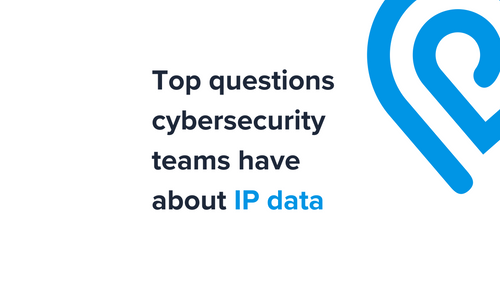Fraud and cyber threats are on the rise. Because of this, the role of cybersecurity teams and SOCs are increasing as well. The reality is that these teams are facing an onslaught of challenges.
But incident response time, attack surface management, and actionable threat detection depend on a variety of indicators. Indicators that, if inaccurate, can lead to undetected data breaches, account takeovers, ransomware attacks, and many other unmitigated risks.
Because of this, cybersecurity organizations often ask similar questions when weighing their options for IP data. These are some of the most common.
1. Is this data accurate enough to build reliable threat intelligence?
The last thing cybersecurity teams need is more false alerts distracting them from real threats. According to a study conducted in 2021, each day over 50 percent of security teams have more than 500 alerts. Plus, anywhere from 20 to 40 percent of those alerts are false.
It’s now 2023, and cyber threats have only increased since that report was written. The good news is that every day, IPinfo updates, verifies, and improves our data. Read more about that process here.
We take data accuracy very seriously at IPinfo. In fact, it’s our top priority. We’re aware that, if we don’t improve our data every day, we could slow down important security investigations.
Nethone, a fraud detection platform, noted that “Getting the same quality data as IPinfo with an in-house team is actually quite difficult. That’s why we chose IPinfo.” This is the story we’ve heard many times from security teams.
Another cybersecurity customer had this to say about IPinfo’s data in comparison to other IP data providers: “Our service was originally using another #IPlookup company & you guys have blown them out of the water. Way more accurate, up-to-date & the available data is incredible. Thanks!”
All this to say, IPinfo’s data is accurate for reliable threat intelligence.
2. Will implementing this data improve our team efficiency or slow us down?
Another study found that more than 90 percent of security organizations are unable to investigate all alerts during the course of a day. Therefore, third-party data sources that slow down team efficiency are not feasible.
IPinfo, however, is built for quick implementation. Our proprietary database is built by developers for developers. We provide quick setup APIs, documentation, libraries, and supported integrations for customers who prefer self-serve solutions.
These solutions also have 99.99 uptime and low latency. Read more about getting started with IPinfo.
Graylog, a leading centralized log management company, noticed right away that IPinfo was “really easy to do business with…. They understood our problem, understood what we needed, and immediately understood our level and how technical we are. So we wasted no time. It was an incredibly easy process.”
For organizations that need to ingest more data, IPinfo provides customizable database downloads. But since aggregating various threat intelligence feeds and data in one single place is a tedious task, IPinfo and Snowflake have partnered together to make threat intelligence more easy and seamless by providing accurate and up-to-date IP address data on Snowflake Marketplace. Check out our integrations page for more ways to use IP address data at scale.
Plus, for Enterprise organizations, our data experts regularly help problem-solve and implement intricate use cases. In short, IPinfo’s infrastructure and team organization is designed to improve efficiency for our users.
3. How quickly does IPinfo process data corrections?
IP address data is a moving target, meaning that the insights always need to be monitored. Since data errors have a negative impact on cybersecurity customers and threat detection, we’ve provided a way for organizations to report incorrect IPs.
A common concern among cybersecurity users is how quickly will corrections be implemented. When users submit data feedback or corrections, IPinfo moves fast to correct these discrepancies in our database.
Customer support has always been a top priority at IPinfo. Normally, we process and verify corrections within 48 hours. We also offer additional support such as support SLA for Enterprise users. Read more here.
Data discrepancies can be reported here, giving users the option to report individual IP errors or bulk corrections submitted via geofeed.
4. Can we get all our IP data in one place or will we need multiple providers?
More providers can mean more headaches for security teams and SOCs that are already investigating hundreds of alerts every day. They don’t need complicated data providers. Additional third-party providers can also rapidly increase costs.
That’s why cybersecurity organizations often ask about how many data types they can get from IPinfo. We provide access to 10+ data types, including these:
In addition, we offer comprehensive domain name data with Host.io to help security teams uncover new domains and the relationships between them.
Users regularly get all of their IP data directly from IPinfo.
5. What do IPinfo’s data fields mean?
Many cybersecurity teams want to make sure they understand our data fields before implementing their use case.
I am a HUGE advocate for @ipinfoio and if you’re doing threat intel, pentesting or bug bounty or any security domain it is insanely invaluable. - Ben Bidmead – Founder & President of 0x00sec
For instance, we’ve had cybersecurity users ask questions about our database and schema like these:
- What datasets do you recommend for a vulnerability management company to map the surface area of an attack?
- What does the IPinfo dataset look like in Snowflake?
- What is the meaning of “relay” in the Privacy Detection dataset and how does this affect our use case?
- What IP address datasets are crucial for determining fraud risk?
- Is CSV the format for IP Range data?
- How are city names encoded in the IP to Geolocation database?
Our data experts regularly answer questions like these to ensure reliable use cases for security teams. So if you haven’t yet, now is a great time to connect with one of our experts and ask your questions.
Connect with a data expert today!
